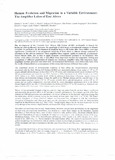| dc.description.abstract | The development of the Cenozoic East African Rift System (EARS) profoundly re-shaped the landscape and significantly increased the amplitude of short-term environmental response to climate variation. In particular, the development of amplifier lakes in rift basins after three million years ago significantly contributed to the exceptional sensitivity of East Africa to climate change compared to elsewhere on the African continent. These amplifier lakes respond rapidly to moderate, processional forced climate shifts, and as they so apply dramatic environmental pressure to the biosphere. Rift basins, when either extremely dry or lake-filled, form important barriers for migration, mixing and
competition of different populations of animals and hominins. Amplifier lakes link long-term, high amplitude tectonic processes and short-term environmental fluctuations. East Africa may have been the cradle of humankind as a consequence of this strong link between different time-scales. | en |

